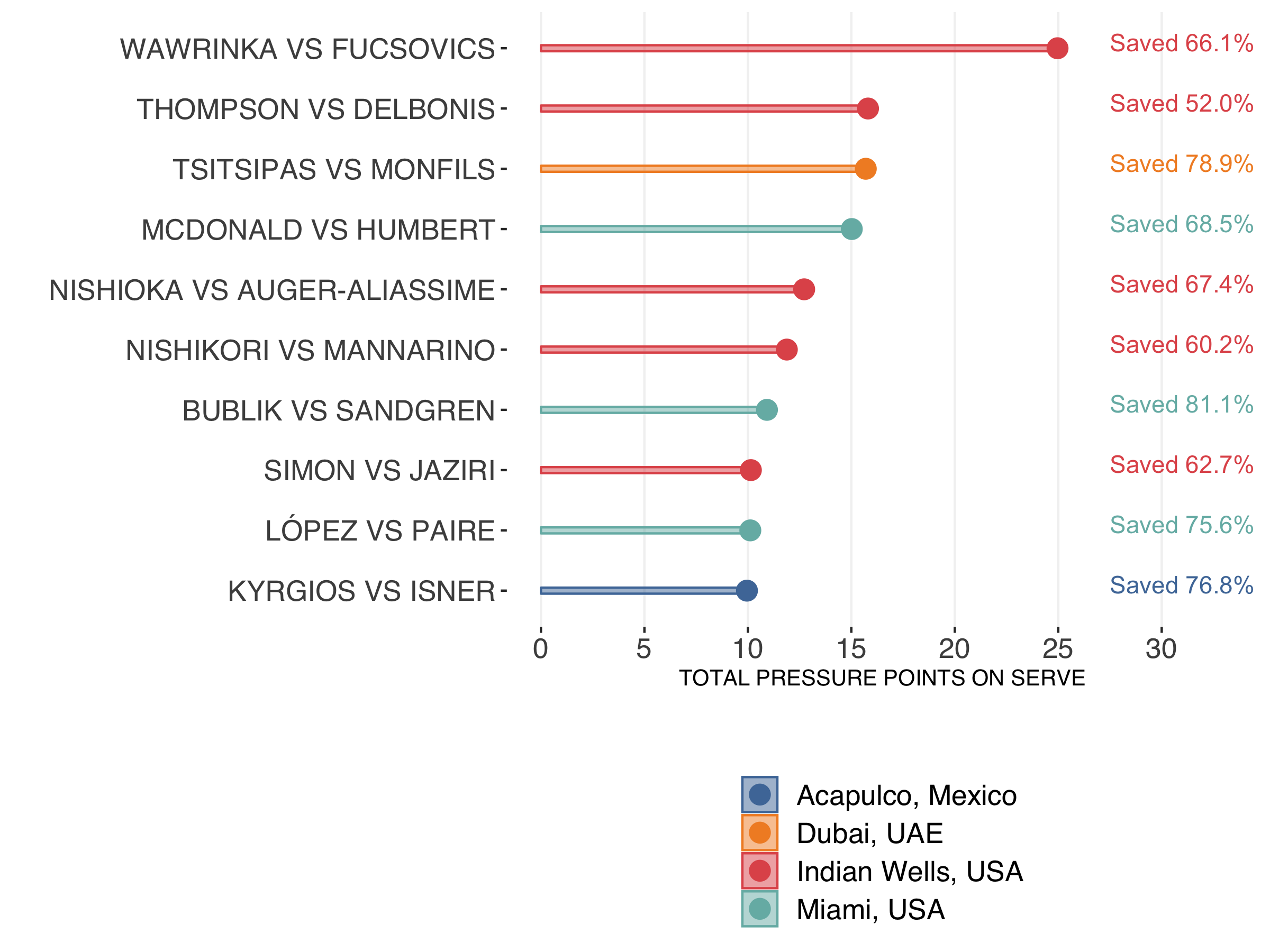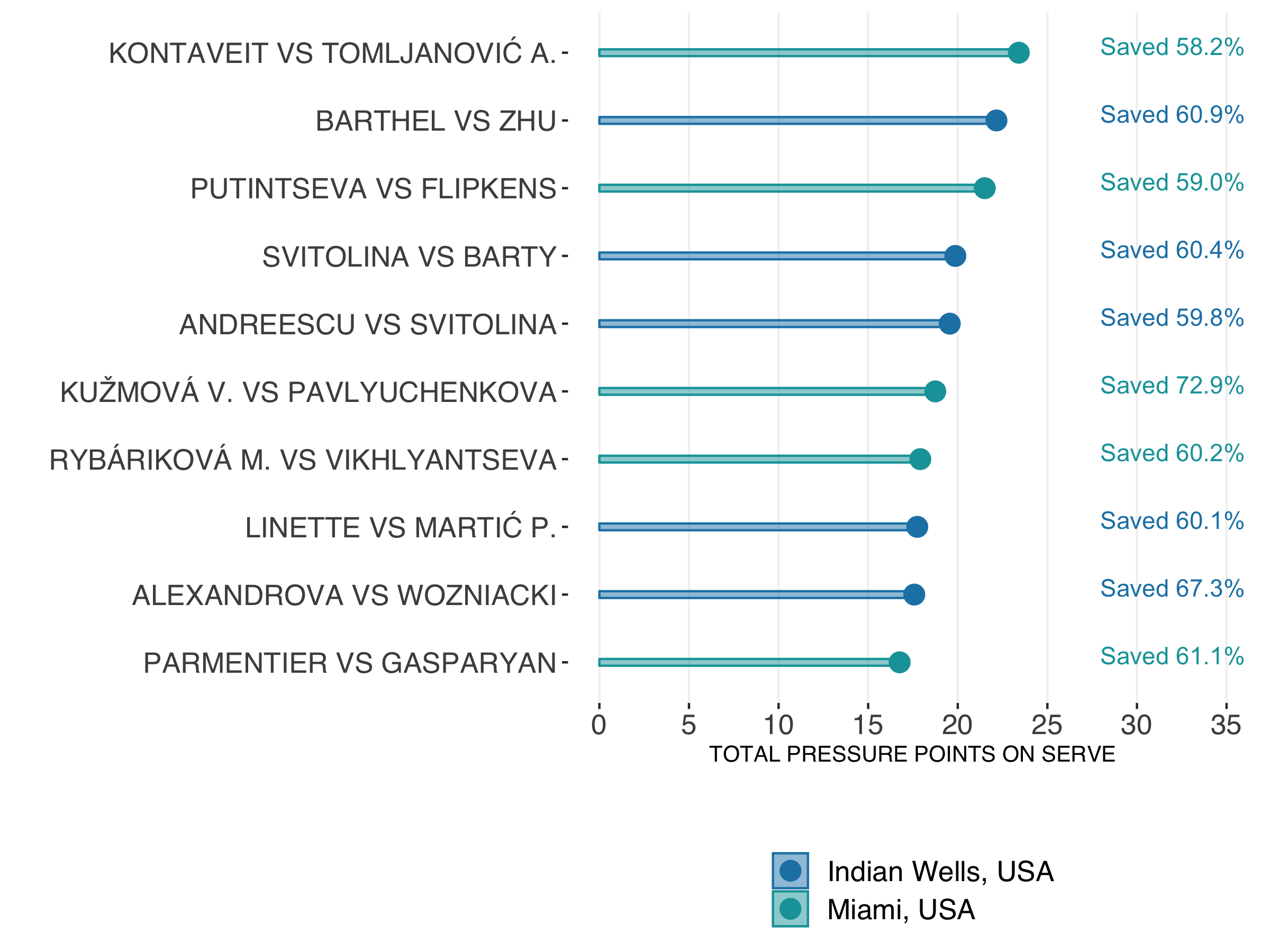Top Pressure Performances in March
Ahead of the final matches in Miami this weekend, we look back on the players who triumphed in the face of the most pressure-filled matches so far this month.
March is the month of the Sunshine Double, the two biggest and most talent-packed ATP Masters and WTA Premier events on the calendar. Indian Wells delivered two Cinderella stories, with Dominic Thiem nabbing his first Masters title there and teen phenom Bianca Andreescu becoming the tournament’s first wildcard entry to take the trophy. Miami still has its champions to crown, with Denis Shapovalov, Felix Auger-Aliassime, and Ash Barty poised to make the most headlines.
Even with the Miami titles still to be decided, we can already say that this month has given us the most exciting title runs of 2019. But which players have had the most impressive single match performances?
Below are the 10 men’s players who faced the most pressure in a single match out of ATP matches played so far in March. The ‘total pressure points’ here express how much overall pressure the player had to handle on serve in units of match-deciding break points, what I’ve previously called break point equivalents.
The top spot goes to Stan Wawrinka in his 3 hour and 26 minute win over Marton Fucsovics in Indian Wells, in which he faced 25 pressure points, 10 more than the next highest pressure match this month. It was the 3rd set that busted the pressure barometer. In that set alone, Wawrinka played 106 points (5 more than he played in his entire match against Federer in the next round) and faced 12 break points. Although Wawrinka’s 2 of 3 rate of saving pressure points wasn’t the highest among the top 10, it was enough to get the job done.

Four other matches from Indian Wells land on the top 10 pressure performances. One of the most notable was Yoshihito Nishioka’s upset of a soaring Felix Auger-Aliassime. In a match that lasted a few minutes shy of 3 hours, Nishioka faced 12.7 total pressure points, two tiebreaks, and 235 total points. After going two breaks up in the 3rd, Nishioka looked like he might lose his hold of the match, squandering 3 match points before the final set tiebreak. It wasn’t the most efficient win in the end, but he managed to hold on. Though that win might have come at the cost of a retirement in the next round.
Three matches from Miami also make the top 10. One of those includes the strongest save percentage of the group, which was earned by Alexander Bublik in his first round win over Tennys Sandgren. In that 228-point 3-setter, Bublik 10.9 total pressure points on serve and saved 8.9.
Only one other player in the top 10 pressure matches was close to an 80% save rate. This was Stefanos Tsitsipas in his semifinal win at Dubai over Gael Monfils. Over the 3 hours, 266 points, and 2 tiebreaks that made up that match, Tsitsipas faced 15.7 pressure points and saved 12.4. Those numbers make his 1 hour a 11 minute straight set loss to Roger Federer in the final that much more puzzling. Perhaps Federer was out for revenge after his run in with Tsitsipas at the Australian Open.
On the women’s side, the top pressure performance goes to Anett Kontaveit for her third round victory over Ajla Tomljanovic. In the 2 hour and 30 minute match, Kontaveit and Tomljanovic battled over 229 points, including two tiebreaks. Kontaveit faced a total of 23.4 pressure points on serve, saving 13.6. No wonder there were 3 consecutive breaks to take it to a final tiebreak in the 3rd set. Kontaveit must have rode on the high of surviving that match to the semifinal though it wasn’t enough to take on another formidable Aussie, Ash Barty.

Barty, interestingly, was on the wrong side of a high-pressure result earlier in the month, in her loss to Elina Svitolina at Indian Wells. In the 3 hours and 14 minutes, that was kicked off in the 1st set with an 18-point tiebreak, Barty forced Svitolina to face 19.9 pressure points on serve. The competitiveness of that battle made it the 2nd most pressure-filled match at Indian Wells, falling just behind Mona Barthel’s close win over Zhu Lin.
Svitolina got a taste of the same medicine just two rounds later when she confronted Andreescu. Although the game score might not suggest how close that confrontation was the pressure stats do. Over the 188 points Svitolina and Andreescu fought out, Andreescu faced 19.6 total pressure points on her serve, saving 59.8%. Andreescu’s ability to keep her fight and composure under that kind of pressure, and against such a strong opponent as Svitolina, had to give her that much more confidence towards her maiden Premier title.

